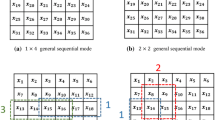Abstract
In recent years, pixel value ordering (PVO) and prediction-error expansion (PEE) methods are combined to better exploit the pixel correlation in reversible data hiding (RDH) techniques. In these techniques, the cover image is split into non-overlapping blocks of equal size. The pixels of each block are sorted in ascending, according to their intensity values. The maximum and minimum pixels within each block are used to calculate prediction errors which are either expanded or shifted for embedding data. The data are embedded into smooth blocks which are identified using every two adjacent pixels of neighbor block. However, this block classification is not very effective since it considers only the neighbor block and ignores the pixels in current block. In this paper, to overcome this drawback and to improve the performance further, a novel reversible data hiding using context pixel-based block selection (CPBS) strategy is proposed. After the block division and sorting process, the complexity of each block is measured using the context pixel chosen from the current block and the connected pixels of neighbor block. Smooth blocks with low complexity are determined using a threshold value to achieve higher efficiency. When the desired capacity is achieved, the index orders of all pixels in the block are preserved and thus the reversibility is guaranteed. Experimental results verify that the proposed scheme achieves better capacity-distortion trade-off and thus outperforms with the existing PVO-based techniques.
Access this chapter
Tax calculation will be finalised at checkout
Purchases are for personal use only
Similar content being viewed by others
References
Shi, Y.Q.: Reversible data hiding. In: Cox I.J., Kalker T., Lee H.K. (eds.) Digital Watermarking. IWDW 2004. Lecture Notes in Computer Science, vol. 3304, pp. 1–12. Springer, Berlin, Heidelberg (2005)
Fridrich, J., Goljan, M., Du, R.: Lossless data embedding—new paradigm in digital watermarking. EURASIP J. Appl. Signal Process. 185–196 (2002)
Celik, M.U., Sharma, G., Tekalp, A.M., Saber, E.: Lossless generalized-LSB data embedding. IEEE Trans. Image Process. 14(2), 253–266 (2005)
Zhao, H., Wang, H., Khurram Khan, M.: Statistical analysis of several reversible data hiding algorithms. Multimed. Tools Appl. 52(2), 277–290 (2011)
Tian, J.: Reversible data embedding using a difference expansion. IEEE Trans. Circ. Syst. Video Technol. 13(8), 890–896 (2003)
Alattar, A.M.: Reversible watermark using the difference expansion of a generalized integer transform. IEEE Trans. Image Process. 13(8), 1147–1156 (2004)
Wang, X., Li, X., Yang, B., Guo, Z.: Efficient generalized integer transform for reversible watermarking. IEEE Signal Process. Lett. 17(6), 567–570 (2010)
Tai, W.L., Yeh, C.M., Chang, C.C.: Reversible data hiding based on histogram modification of pixel differences. IEEE Trans. Circ. Syst. Video Technol. 19(6), 906–910 (2009)
Li, X., Yang, B., Zeng, T.: Efficient reversible watermarking based on adaptive prediction-error expansion and pixel selection. IEEE Trans. Image Process. 20(12), 3524–3533 (2011)
Lee, C.F., Chen, H.L.: Adjustable prediction-based reversible data hiding. Digit. Signal Proc. 22(6), 941–953 (2012)
Hong, W., Chen, T.S., Shiu, C.W.: Reversible data hiding for high quality images using modification of prediction errors. J. Syst. Softw. 82(11), 1833–1842 (2009)
He, W., Cai, J., Xiong, G., Zhou, K.: Improved reversible data hiding using pixel-based pixel value grouping. Optik 157, 1–15 (2017)
Ou, B., Li, X., Wang, J.: High-fidelity reversible data hiding based on pixel-value-ordering and pairwise prediction-error expansion. J. Vis. Commun. Image Represent. 39, 12–23 (2016)
He, W., Zhou, K., Cai, J., Wang, L., Xiong, G.: Reversible data hiding using multi-pass pixel value ordering and prediction error expansion. J. Vis. Commun. Image Represent. 49, 351–360 (2017)
Jana, B.: High payload reversible data hiding scheme using weighted matrix. Optik 127(6), 3347–3358 (2016)
Maniriho, P., Ahmad, T.: Information hiding scheme for digital images using difference expansion and modulus function. J. King Saud Univ. Comput. Inf. Sci. 31(3), 1–13 (2018)
Weng, S., Liu, Y., Pan, J.S., Cai, N.: Reversible data hiding based on flexible block-partition and adaptive block-modification strategy. J. Vis. Commun. Image Represent. 41, 185–199 (2016)
Cai, S., Gui, X.: An efficient reversible data hiding scheme based on reference pixel and block selection. In: International Conference on Intelligent Information Hiding and Multimedia Signal Processing. IEEE, Beijing, China (2013)
Jung, K.H.: A high-capacity reversible data hiding scheme based on sorting and prediction in digital images. Multimed. Tools Appl. 76(11), 13127–13137 (2017)
Sachnev, V., Kim, H.J., Nam, J., Suresh, S., Shi, Y.Q.: Reversible watermarking algorithm using sorting and prediction. IEEE Trans. Circ. Syst. Video Technol. 19(7), 989–999 (2009)
Li, X., Li, J., Li, B., Yang, B.: High-fidelity reversible data hiding scheme based on pixel-value-ordering and prediction-error expansion. Sig. Process. 93(1), 198–205 (2013)
Peng, F., Li, X., Yang, B.: Improved PVO-based reversible data hiding. Digit. Signal Proc. 25, 255–265 (2014)
Liu, H.H., Lee, C.M.: High-capacity reversible image steganography based on pixel value ordering. EURASIP J. Image Video Process. 54, 1–15 (2019)
Author information
Authors and Affiliations
Corresponding author
Editor information
Editors and Affiliations
Rights and permissions
Copyright information
© 2020 Springer Nature Singapore Pte Ltd.
About this paper
Cite this paper
Mahasree, M., Puviarasan, N., Aruna, P. (2020). An Improved Reversible Data Hiding Using Pixel Value Ordering and Context Pixel-Based Block Selection. In: Singh, P., Pawłowski, W., Tanwar, S., Kumar, N., Rodrigues, J., Obaidat, M. (eds) Proceedings of First International Conference on Computing, Communications, and Cyber-Security (IC4S 2019). Lecture Notes in Networks and Systems, vol 121. Springer, Singapore. https://doi.org/10.1007/978-981-15-3369-3_64
Download citation
DOI: https://doi.org/10.1007/978-981-15-3369-3_64
Published:
Publisher Name: Springer, Singapore
Print ISBN: 978-981-15-3368-6
Online ISBN: 978-981-15-3369-3
eBook Packages: Intelligent Technologies and RoboticsIntelligent Technologies and Robotics (R0)




